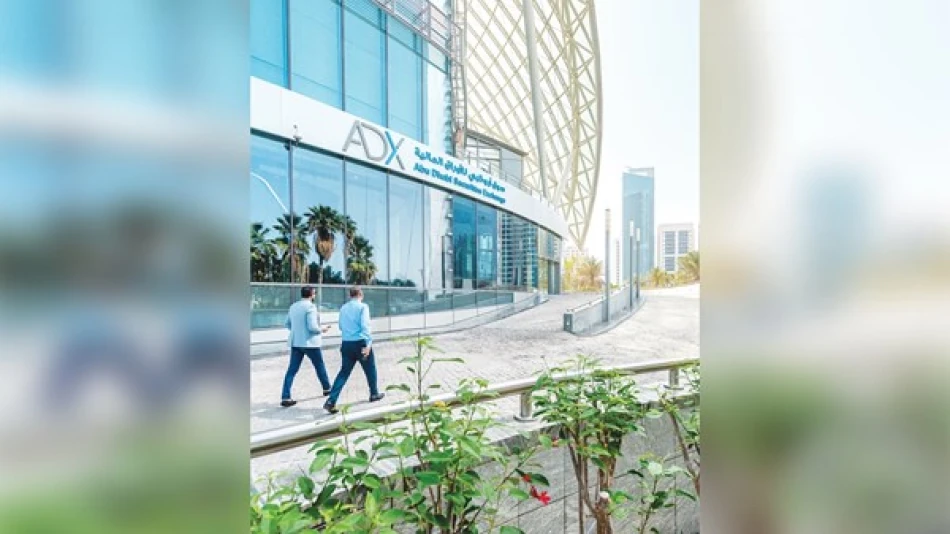
Abu Dhabi Stocks Gain $8.4 Billion in Market Value in a Week
Abu Dhabi Stock Exchange Hits Record High as FTSE Russell Changes Drive Foreign Investment Surge
The Abu Dhabi Securities Exchange (ADX) reached a historic milestone last week, adding AED 31 billion to its market capitalization and hitting a record AED 3.128 trillion valuation. The surge coincided with FTSE Russell's implementation of index changes for UAE markets, triggering massive foreign buying that totaled AED 2.576 billion across both Abu Dhabi and Dubai exchanges—signaling a potential shift in how international investors view Middle Eastern markets.
Foreign Capital Flows Reshape Market Dynamics
The timing of this rally is no coincidence. FTSE Russell's index adjustments have created a compelling entry point for international fund managers who must track these benchmarks. Non-Arab foreign investors dominated Abu Dhabi trading, accounting for 44.5% of total trading value while generating net purchases of AED 1.373 billion.
This foreign buying pattern mirrors similar index-driven rallies seen in emerging markets like India and Taiwan when they received MSCI upgrades. The difference here is the scale—UAE markets are attracting capital at a time when many investors are rotating away from overvalued Western markets toward regions offering both growth and attractive valuations.
Institutional Money Leads the Charge
Institutional investors in Abu Dhabi posted net purchases of AED 581.41 million, buying AED 6.306 billion worth of shares while selling AED 5.725 billion. This institutional appetite suggests sophisticated money managers see fundamental value beyond the technical index flows.
The contrast with retail behavior is telling: individual UAE investors were net sellers of AED 1.188 billion, effectively providing liquidity to incoming foreign capital. This dynamic often signals the early stages of a sustained uptrend, as local retail investors typically sell too early while institutional money accumulates positions.
Market Performance Tells Two Different Stories
While Abu Dhabi's main index surged 110.54 points to close at 10,128.14—a gain of over 1%—Dubai's market painted a different picture. The Dubai Financial Market index declined marginally by 7.34 points to 6,023.21, despite foreign investors pumping AED 1.388 billion into Dubai stocks.
This divergence reflects the different compositions and liquidity profiles of the two exchanges. Abu Dhabi's market, anchored by energy giants and government-linked entities, offers the scale and stability that large institutional investors prefer. Dubai's market, while more diverse, lacks the mega-cap stocks that can absorb significant capital flows without major price disruption.
New Listing Adds Market Depth
The listing of Orascom Construction on ADX, with an initial market value of AED 3.3 billion, demonstrates the exchange's growing appeal as a listing destination. This follows a broader trend of Middle Eastern exchanges competing for high-quality listings as companies seek alternatives to traditional Western markets facing increased regulatory scrutiny and volatile valuations.
What This Means for Global Investors
The UAE market rally represents more than just index-driven flows—it signals a structural shift in global capital allocation. With oil prices stabilizing above $80 per barrel and the UAE's economic diversification efforts gaining traction, the country offers exposure to both energy recovery and non-oil growth stories.
For portfolio managers, the UAE presents an attractive risk-reward proposition: a stable political environment, strong currency pegged to the dollar, and increasing integration with global financial markets. The recent performance suggests international investors are recognizing these fundamentals, moving beyond the traditional view of Gulf markets as pure oil plays.
However, the concentration of buying in Abu Dhabi versus the mixed performance in Dubai highlights the importance of selectivity. Investors are clearly favoring liquid, large-cap names over smaller, less established companies—a pattern that typically characterizes the early stages of sustained foreign investment cycles.
The key question now is whether this foreign interest can be sustained beyond the initial index-driven flows. Early indicators suggest yes: the combination of strong institutional buying, improving economic fundamentals, and attractive valuations relative to global peers creates a foundation for continued international investment in UAE equities.
Most Viewed News

 Layla Al Mansoori
Layla Al Mansoori






